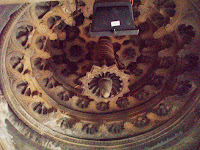Kamala Narayana is a breathtakingly beautiful temple dedicated to Lord Narayana aka Lord Vishnu. It was built in the 12th century at the behest of Kamaladevi, the Kadamba queen.
Kadambas were an ethnic Kannada royal dynasty established by Mayurasharma in the third/fourth century. They were vassals of the Chalukya kings and later the Rashtrakutas. They came to rule vast tracts of land in North Karnataka(Banavasi,Hangal,Halasi) and Goa.
The temple is located in a obscure village Degaon, around 10km from Kittur, Dist Belgaum,Karnataka (north) state in southern India.
It was said to have been constructed by the architect Tippoja for the Kadamba king and is a testament to his architectural genius.
The temple consists of mainly three cells.
One houses the idol of Lord Narayana, the other has Lord Narayana with Godess Laxmi seated on his lap and surrounded by statuetes of Garuda and Hanuman. The third cell houses an image of Kamaladevi who patronised this temple and is flanked by two attendents in stone.
The entire temple is replete with polished pillars , intricately carved walls, ornate lotus designed ceiling,floral motifs, figurines of animals,reptiles,deities,nymphs et al.
The temple also has inscriptions carved in halegannada, a old Kannada script which provides information about the temple and its builders.
The slanting roof has a hemispherical dome over it and below it is the entablature , the ceiling , supported by columns.Carved pilasters, gavaksas-aedicules have also been used generously in the temple design.
The sabhamandapa is sufficiently ventilated with short walls separated by pillars creating huge openings between them. The temple is surrounded by a clean and well maintained green lawn which make the temple premises even more attractive.
Similar Kadamba temples can be found around Belgaum district, in north Kanara and Goa, though the Kamala Narayana temple is unique in its own right. The Hoysalas too seem to have borrowed heavily from this Kadamba style of construction and is evident from their temples located around Mysore.
One can say with conviction that one just cannot walk away from this temple without falling in love with its artistry and harbouring a desire to visit again.
Text and Photographs : Abhijit Rajadhyaksha .






















No comments:
Post a Comment